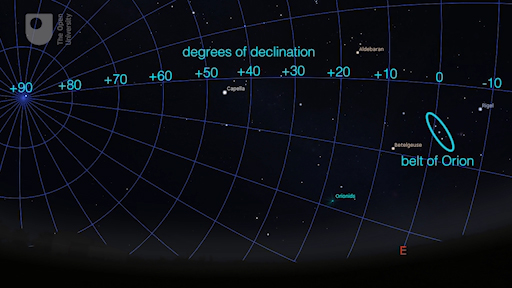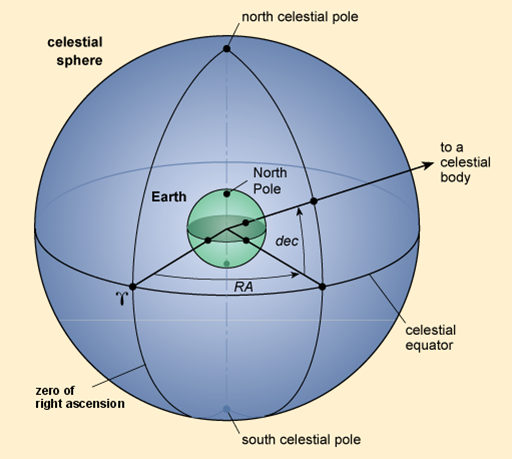3.3 Equatorial celestial coordinates – right ascension and declination
While the Alt-Az system of coordinates has certain benefits and uses, it also has the disadvantage that the coordinates of a given object are not fixed – they change with time as the Earth rotates and will also be different for observers in different locations. This is because the Alt-Az grid is fixed relative to the ground at a particular location.
To describe the position of an object uniquely we need a system of coordinates that is fixed relative to the objects in the sky, rather than to a point on the Earth’s surface. This can be done using a system of celestial coordinates known as the Equatorial system. This system uses coordinates called right ascension and declination (often abbreviated to RA and Dec).
To find out about this system, let’s go back to Alan in Tenerife…

Transcript
One way to visualise this system is to imagine the Earth at the centre of a great sphere on which all of the objects in the night sky and the RA – Dec grid system are drawn. This is known as the celestial sphere. In other words, rather than having a grid fixed relative to the observer, it is fixed relative to the objects in the sky and thus moves with them.

This system has the tremendous advantage of describing the location of an object in the sky to another observer in a way that will never change regardless of when or where they are looking at the time or location of observation. As before, you can explore this using Stellarium.
Activity 6 Equatorial coordinates
Open Stellarium and set the time as before to give a night-time view of the sky. Turn off the Azimuthal grid by clicking the icon again and switch on the Equatorial grid using the icon immediately to the left of it.
- Select a bright star near the Eastern horizon. Although any star will do, try to pick one that has the name next to it (e.g. Altair or Aldebaran) – this will make it easier to follow as it moves across the sky.
- Now click on the star (or tap if you are using a touchscreen device). This will highlight the star and will also display information about it as text in the upper left hand corner of the screen. [On a mobile device the information will appear at the top of the screen: you may have to tap the triangular down-arrow to open up the full information.]
- Find the RA and Dec coordinates (look for a line beginning “RA/Dec (J2000.0)” or on a mobile device ‘RA/DE (of date)’.
- The ‘h’ and ‘m’ in the RA coordinate refer to hours and minutes of Right ascension. The ‘°’ and ‘ symbols in the Dec coordinate refer to degrees and arcminutes. There are 60 arcminutes in one degree, just as there are 60 minutes in one hour. In each case you can disregard the figures after these, which represent even smaller divisions.
- Watch for a few moments. You will notice that the coordinates do not change as time passes.
- Step forward one hour at a time and note what happens to the coordinates as the object moves across the sky.
In completing Activity 6 you will have found that the coordinates of your chosen celestial object do not change. The coordinate grid moves with the object, meaning that each object in the night sky has its own unique position described by the RA and Dec coordinates that is independent of where on the Earth or at what time it is observed.
This equatorial grid system based on the concept of a celestial sphere is therefore the one most commonly used in astronomy and is used on star charts and in astronomical catalogues, where each object will be listed with its own unique RA and Dec coordinates. This is also the coordinate system used to control telescopes such as COAST.
One minor exception to be aware of is that while the positions of stars and other distant objects such as nebulae and galaxies are fixed in the equatorial system, the coordinates of objects within our own solar system (such as the Moon, planets, comets and asteroids) will change as they orbit around the Earth or the Sun.
